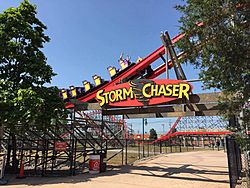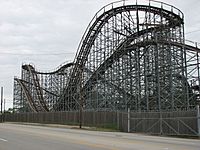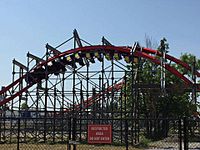Storm Chaser (roller coaster) facts for kids
Quick facts for kids Storm Chaser |
|
|---|---|
| Previously known as Twisted Sisters (1998-2001) and Twisted Twins (2002-2007) | |

Ride entrance
|
|
| Kentucky Kingdom | |
| Location | Kentucky Kingdom |
| Coordinates | 38°11′45″N 85°45′01″W / 38.1958°N 85.7503°W |
| Status | Operating |
| Soft opening date | April 28, 2016 |
| Opening date | April 30, 2016 |
| Cost | $10 million |
| Replaced | Twisted Twins |
| General statistics | |
| Type | Steel |
| Manufacturer | Rocky Mountain Construction |
| Designer | Alan Schilke |
| Model | I-Box – Custom |
| Lift/launch system | Chain lift hill |
| Height | 100 ft (30 m) |
| Length | 2,744 ft (836 m) |
| Speed | 52 mph (84 km/h) |
| Inversions | 3 |
| Duration | 1:40 |
| Max vertical angle | 78° |
| Capacity | 960 riders per hour |
| G-force | 3.8 |
| Trains | 2 trains with 6 cars. Riders are arranged 2 across in 2 rows for a total of 24 riders per train. |
| Storm Chaser at RCDB | |
Storm Chaser is an exciting steel roller coaster located at Kentucky Kingdom in Louisville, Kentucky. It was designed by Alan Schilke and built by Rocky Mountain Construction. The ride cost about $10 million to create. It first opened to the public on April 30, 2016.
This thrilling coaster features three upside-down sections, called inversions. It uses a special track technology called I-Box. Storm Chaser also has a steep 78-degree drop and can reach a top speed of 52 miles per hour (84 km/h).
Storm Chaser was built where another roller coaster, called Twisted Twins, used to be. Twisted Twins was a dueling roller coaster that opened in 1998. To save money, some parts of the old Twisted Twins track and supports were used for Storm Chaser. Storm Chaser was the second new coaster to open at Kentucky Kingdom since the park reopened in 2014. It was even nominated for "Best New Ride For 2016" by Amusement Today.
Contents
How Storm Chaser Was Built
From Twisted Sisters to Twisted Twins
In September 1997, a company called Premier Parks bought the rights to operate Kentucky Kingdom. Soon after, in November 1997, they announced plans for a new $5-million dueling roller coaster. It was first going to be called Double Trouble. But before it opened in 1998, its name was changed to Twisted Sisters.
In June 1998, Premier Parks bought Six Flags. Because of this, Kentucky Kingdom became Six Flags Kentucky Kingdom. In 2002, a music band called Twisted Sister said they would take legal action because of the roller coaster's name. To avoid a lawsuit, the park changed the ride's name to Twisted Twins. It operated under this name until the end of the 2007 season. After that, the ride closed down.
The Park's Challenges and Reopening
On February 4, 2010, Six Flags announced that Kentucky Kingdom would close. This happened because of money problems. Ed Hart, who used to run Kentucky Kingdom, tried to reopen the park with other investors. But their plans didn't work out after many months of talks.
Later, on June 27, 2013, Ed Hart's group made a new deal. They agreed to spend $36 million to reopen the park in May 2014. They also planned to change Twisted Twins into a "much better ride." They hoped to open this new ride in 2016.
Building Storm Chaser
The park hired Rocky Mountain Construction to rebuild the roller coaster. They used a special track design called IBox. In July 2015, Kentucky Kingdom announced the new ride would be named Storm Chaser. It was set to open in 2016 and cost about $10 million.
What Makes Storm Chaser Special?
Twisted Twins: The Original Ride
The original Twisted Twins was a dueling roller coaster. This meant it had two separate tracks that started from the same station. The two tracks followed different paths but crossed each other four times. Both tracks were about 3,000 feet (910 m) long and 80 feet (24 m) tall. They reached speeds of up to 55 miles per hour (89 km/h).
Twisted Twins was the only dueling roller coaster made by Custom Coasters International. Each track had one train, named Stella and Lola. Each train could hold 28 riders. Riders needed to be at least 48 inches (120 cm) tall to ride.
Storm Chaser: The New Experience
Park officials said that Storm Chaser used some parts of the old Twisted Twins structure. But they also said it was a completely new ride. Storm Chaser uses Rocky Mountain Construction's IBox steel track system. This track makes the ride feel smooth like a steel coaster. It also has the fast pace of a wooden coaster. The new track also allows the train to go upside down, which is not common for wooden roller coasters.
Comparing the Rides
Let's look at how Twisted Twins and Storm Chaser are different:
| Statistic | Twisted Twins (Twisted Sisters) | Storm Chaser |
|---|---|---|
| Years Operating | 1998-2007 | 2016–Present |
| Manufacturer | Custom Coasters International | Rocky Mountain Construction |
| Track Type | Wood | Steel |
| Track Layout | Dueling | Out and back |
| Height | 80 ft (24 m) | 100 ft (30 m) |
| Length | 3,000 ft (910 m) | 2,744 ft (836 m) |
| Speed | 55 mph (89 km/h) | 52 mph (84 km/h) |
| Max Vertical Angle | Unknown | 78° |
| G-force | 3.2 | 3.8 |
| Capacity | Unknown | 960 riders per hour |
| Duration | 2 minutes, 12 seconds | 1 minute, 40 seconds |
| Inversions | 0 | 3 |
| Trains | Gerstlauer | Rocky Mountain Construction |
What's the Ride Like?
When you get on Storm Chaser, the train leaves the station and makes a right turn. Then, it starts climbing up the lift hill. After reaching the very top, the train banks left and drops down in a cool barrel-roll. This brings you back to the ground!
Next, you go over an airtime hill, which gives you a feeling of weightlessness. After that, you'll experience an overbanked left turn that tilts you almost upside down for a moment. Storm Chaser then climbs another hill and turns right. It then turns left, heading back in the other direction. You'll go through another overbanked turn to the right.
The train then goes over another airtime hill. After this, it banks right and enters the final inversion, a corkscrew. As you exit the corkscrew and bank left, you'll pass over several camelback hills. These hills make the train bank from side to side. Finally, the train enters a 270-degree banked helix to the right. It then rises to the left before hitting the final brakes and returning to the station.



